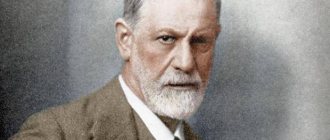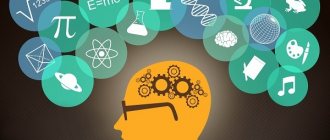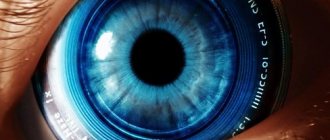The development of memory, attention and thinking is very important in the 21st century. We have to remember a lot of important things around the house, school, work, and so on. We are surrounded by a huge number of complex technical devices, which are constantly becoming more complex and their number is constantly growing.
Memory needs to be developed from childhood and continued to be trained as an adult. In this article, I have collected more than 20 effective exercises, games, courses and tasks for developing memory and attention.
- 8 Exercises for Everyday Workout
- 20 exercises to train memory and attention
- Memory development courses
- Games for memory and attention
How can you develop memory and attention if you urgently need to start somewhere?
Bad memory?
No, this is not about me. Here I taught my daughter a poem. I, with my wise logic, practice of studying in three higher educational institutions, the ability to connect anything and everything, knowledge of how to develop memory in an adult, exercises for effective memorization (psychology department) and my third-grader daughter. Who will remember faster? Of course it's me. I had no doubts) But when we started learning the poem and repeating the lines, it turned out that she remembers much better, her memory is like a sponge.
He took in the water and squeezed out the water. Of course, early training using the Makoto Shichida method has an effect. But still.
And my memory needed preliminary work - searching for associations, what it looked like, what to connect with, it was not easy. And after so much tying work, I still couldn’t remember the lines.
And then I seriously thought about the memory of an adult. Are there effective exercises for developing memory and attention? What should I do?
Indeed, with age, cognitive abilities, which include memory, become more specific, selective, and economical.
But there is a solution!
Classification of memory according to the time it saves information
Based on the duration of information storage, they distinguish between instantaneous, short-term (and operational memory, which was previously identified with short-term, but is now more often considered its operational component), and long-term memory.
Instant memory is stored for a very short period of time, up to 3 seconds, and its task is to perceive information from the senses as fully as possible and, without processing, transfer it further to short-term memory.
Short-term memory retains information in a small volume for a short time (about 30 seconds) (on average about 7 objects). At this stage, a decision is made about whether it needs to be transferred to long-term memory. The important thing is that without repetition, information is forgotten over time, “erased.” Short-term memory “selects” from the received data the most important thing, something that can be useful, a certain generalized image.
Random access (working) memory is an active process that allows you to work with information stored in short-term memory, manage it, and organize it. This is a kind of intermediate form of memory (between short-term and long-term), acting depending on a certain period of completion of the assigned memorization task (seconds or days). Once the task is completed, the information is erased. Thanks to this memory, we, for example, pass an exam in an unloved subject, after which sometimes we completely forget everything we have learned. Working memory also manifests itself when, in response to an unexpected question, we not only answer, but also, holding the question in our heads, plan what we will say next, how we will develop our thought. Thanks to it, we remember purchases and roughly calculate the amount, moving towards the checkout, and so on.
Long-term memory can store information for a long time, sometimes throughout life. True, we still need to extract it from storage. For long-term memorization, you need meaningful, well-structured information associated with already “rooted” knowledge.
As a rule, it is the inability to quickly and effectively carry out the work of comprehending new material, structuring it and linking it with existing knowledge that causes difficulties in transferring material from short-term memory to long-term memory and, accordingly, complaints about weak memory . Information placed in short-term memory must be “decoded” in order to be remembered, that is, it must become understandable to our brain.
What is memory?
Memory is the most important feature of the human psyche, with the help of which we remember, save, and then recall and use in our lives what we remember.
When we remember, so-called traces are stored - images of the reality around us in the cerebral cortex. Unnecessary information is erased.
Scientists have already described a huge number of types of memory. You can read about the types in our articles. Therefore, let’s immediately get down to what happens to memory in adults.
Books
It’s not for nothing that I wrote about poetry in my advice. They train and increase memory capacity. Books work the same way.
Reading develops memory, because when we read, images arise, we remember the plot, we experience it. Very useful reading. And reading about the development of our mental processes is even more useful.
Therefore, I suggest you take the time to study super books:
- Denis Bukin “Development of memory using the methods of special services”
- Ryuta Kawashima “Train your memory. Japanese system for maintaining brain health”
- Jonathan Hancock “How to train your memory. Don’t think about memory - better use it to the fullest!”
- Stanislav Matveev “Phenomenal memory. Methods for memorizing information”
- Kevin Horsley “Limitless memory. Remember quickly, remember for a long time"
The scary truth or what happens to memory as you grow older
Growing up and developing, a person reaches his peak of cognitive abilities, which also includes memory, this happens by the age of 35.
Thus, between 30-33 years of age, memory, thinking and attention receive maximum development, but by the age of 40, their functions begin to decline.
The peak of creative activity depends on the types of activities in which a person is engaged. So a mathematician, chemist and physicist achieve it at 30-34 years old, and a physician and geologist at 35-39 years old.
The longest and most far-reaching are politicians, psychologists and philosophers; the peak of their creative activity occurs between the ages of 40-55 years.
But we know people (including outstanding ones) who, even at 80 years old, retain youthful thinking, excellent memory and create amazing things.
If a person’s profession is related to creativity, then as he grows up, he not only does not forget anything, but, on the contrary, improves his professional memory.
The most interesting thing is that the preservation and development of our memory is influenced by what we do, what we strive for, whether we are looking for new information, whether we want to remember something new.
This maintains and develops new connections in the brain. Yes, the number of neurons in the brain, through which we think and remember, decreases by 30% by the age of 80, but the process of their formation and death is constant.
The most important thing is how we use the phoenix bird.
Whether we build new connections between neurons, pathways that bypass damaged neurons, or not. A large number of them were discovered in Einstein's brain.
These stripes between neurons are the new synaptic connections we need. Therefore, at any age you need to study memory. Moreover, it is always effective to develop memory and attention.
Growing up, a person acquires a huge amount of experience, stores it in memory, these are huge amounts of information. Therefore, he can tell much more than a young man is able to do.
Exercises for memory development in preschoolers
The brain needs to be trained at a very young age. When a child assembles a pyramid of rings, having repeated the construction of this structure several times, he will soon remember that first he must put the largest donut on the pin, then smaller ones, and the smallest ones on top. A cone or asterisk is installed on the top.
Learning short rhymes, like:
“A clubfooted bear is walking through the forest,
He collects pine cones and sings a song.
Suddenly a cone fell, right on the bear’s forehead,
the bear got angry and kicked: stomp!
It's very fun to imitate the gait of a bear, hit yourself on the forehead and stamp your foot in the right place. These simple manipulations add visual and motor memory to auditory memory.
Fairy tales with frequent repetitions: “A mouse for a cat, a cat for a bug, a bug for a granddaughter, a granddaughter for a grandmother, a grandmother for a grandfather, a grandfather for a turnip,” develop auditory and visual memory, if you look at a colorful book with pictures.
Compiling pictures from puzzles develops attention to detail and visual memory. The child constantly has to compare a piece of the drawing with the general image.
Which brain, an adult’s or a child’s, learns faster?
In fact, the brain learns in exactly the same way, both in a child and in an adult. How does this happen? Scientists have proven that the brain spends the same amount of time on learning in both adults and children.
So why do children learn faster? Because they don’t have other worries like adults, they have more free time and motivation. But we adults can do it too if we want)
And there is one secret. To change, the brain must be willing to change. What does it mean to be ready for change?
For example, with the best intentions you force a child to learn something, it seems like he is learning, but there is no benefit. Why?
Because the brain cannot change when it is not interested, bored. There should always be at least some emotion present.
Maria Ammon, president of the German Academy of Psychoanalysis, reports that the brain in adulthood can develop, change, repair itself and is mainly influenced by emotions.
We know for sure from children that a bright emotional coloring promotes memorization.
So, the brain is ready to change when we are very excited or receive a reward, any: monetary, emotional, erotic, cookie.
In this case, dopamine is produced in the brain, which reduces the brain’s resistance to change and to remembering.
Therefore, the secret to developing memory and attention at any age is to reward yourself with a reward or experience a deep emotion.
The brain must know that after memorizing it will feel good) When we are happy, the hormone of joy is produced - dopamine. It is also called the memory hormone.
It is associated with working memory and is needed in order to connect it to action and turn off those areas of the brain that are active in a person when he is not doing anything.
How can you increase dopamine levels?
- The right foods: eggs, cabbage, green tea, seafood, apples, bananas, strawberries and a piece of chocolate)
- Correct actions: intense walks in the fresh air, dancing, playing musical instruments. But everything is in moderation, otherwise an excess of this hormone can lead to devastation and exhaustion.
What else is important to know?
Recommendations
Experts also provide useful advice to adults who are planning memory development.
- Try to strain your brain as soon as possible. Learn a new foreign language, take a driving course, etc.
- Watch intellectual films, visit unusual art exhibitions.
- Meet people more often, communicate more, make connections - do networking.
- Read more, give preference to the classics.
- Learn to manage your emotions, don’t let empty worries and nervousness get the better of you.
- Use the well-known ways to improve cerebral circulation: enjoy fresh air as much as possible, play sports, and learn breathing exercises.
If you want all the methods described above to work, try to follow these recommendations.
You need to know that understanding is not the same as memorizing
Let's be honest, why don't we remember? Because we're growing up? Because memory has deteriorated? But no! We don’t remember because we have forgotten how to remember, we have forgotten how to learn it by heart!
Seeing new information, we understand it, realize it and... forget it. Unless, of course, some information is out of the ordinary) Understanding is not the same as memorizing.
Remembering is like trampling a path in the forest, forming a neural trace, but understanding this does not happen.
Therefore, learning understood material by heart is not only useful, but also necessary for further use of information.
We believe that there is a magic pill, some exercises, the most effective, which should be done for 15-20 minutes a day and our memory will improve.
Of course, it will improve, but this search for the perfect pill delays the development or at least maintaining our memory in good condition.
All you need to do is take a wonderful work, a poem by your favorite author and... learn it by heart.
Start small. 1 line a day, you don’t need much. But repeat this line all day long, so that every word stands before your eyes, so that you can repeat it forwards and backwards.
Next, we add a line every day.
What can interfere?
Causes of memory loss
Have you promised two employees a meeting at the same time? Or have you already forgotten what you ate this morning? Or maybe you don’t remember at all whether that ill-fated iron was turned off?! Your affairs are getting worse...
Indeed, every person has moments of memory deterioration, and for many this is already a tendency.
Reasons for the deterioration of this cognitive process:
- Nervous exhaustion, stress. The brain is aimed at protecting, not at nourishing mental functions.
- Constant lack of sleep. During sleep, the brain restores the entire body. If there is little sleep, it does not have time to do this, and it itself loses its power.
- Alcohol and drug abuse. Memorization is the first thing that suffers from all mental functions. Chemicals have a negative effect.
- Previous anesthesia, medications.
- Lack of B vitamins. These are important substances for the nervous system. If they are deficient, memory will also suffer.
- Various diseases.
If memorization deteriorates, you should not leave it to chance. We urgently need to work on this!
The most effective way when we connect the right hemisphere of the brain
But the fastest and best ways to develop memory and attention are when we use our right hemisphere of the brain.
I. Saunière wrote that by developing the right hemisphere, we develop the entire brain. And when we develop the left hemisphere, we develop only the left hemisphere.
Figurative memory (this also includes photographic memory), which is associated with the right hemisphere, has no boundaries.
Scientists R. Shepard (1967), L. Standing (1973) conducted experiments in which they found that a person is able to effectively recognize complex visual material.
11,000 slides were shown to people who participated in the experiment, and after a month they remembered 73% of what was shown.
But there is no good memory without good attention, imagination and thinking.
What needs to be done to develop such an effective photographic memory of the right hemisphere? There are 6 “magic” exercises (read how we develop the right hemisphere in children in this article).
Brain exercises for older people
Brain exercises for older people are quite simple. Read fairy tales and retell them to your beloved grandchildren, memorize with them children's funny poems about “The Absent-Minded One from Basseynaya Street.” It's fun and enjoyable, and it also preserves your personality.
Intelligence training prevents a person from losing his skills and knowledge. It's not just our muscles that need warming up. Neurons restore their connections and do not die if the brain is loaded with feasible work.
You shouldn’t get too tired, but collecting pictures from puzzles, learning foreign words, walking in the park along an unfamiliar alley, remembering a new route, is necessary for good attention. Doctors recommend brushing your teeth and combing your hair either with your left hand or with your right. Simple experiments, but effective.
Good nutrition and fresh air will be the best helpers for you and your mind. Individuals who lead an active lifestyle do not suffer from senile dementia.
Memory training for adults online. 6 best games for memory development
Exercise to develop photographic memory
This is right-brain memory, and we know that when we develop the right hemisphere, we develop the whole brain.
1. Take a mosaic or any other solid colored objects (for example, cubes or pencils) and arrange them in a row. Look at them for 5 seconds, try to remember.
Then close the row and lay out the same sequence from memory.
You can initially not lay out a row, but scatter cubes or pencils. It will be more difficult this way, because when we lay it out, we remember with our hands. Our brain is very cunning)
We start with 5 subjects, you don’t need to take a lot at once, we train not logic, but photographic memory. You can make the task more difficult. After viewing and memorizing, you need to draw all the objects.
What to do next after you succeed in restoring the sequence? Just add the number of cubes, pencils, mosaic pieces and bring their number to 50.
Training figurative memory
2. Take any picture, it’s better to start with the simplest one, you can take a simple mandala or draw a red circle yourself (any geometric figure, for example, a yellow triangle).
We look at it for 5 seconds, close our eyes and try to see it on the internal screen, under closed eyelids.
We repeat this exercise as often as possible. You can hang this picture somewhere in a visible place so that you can look at it more often. The goal is to see the picture with your eyes closed as it is.
Then the right figurative hemisphere will work.
The most fun and effective games
3. Find the missing item. The point is to find the item that is missing. To do this, use everything you have on hand. I take cards with foreign words, you can take any pictures, cards - 10-15 pieces.
We lay them out in random order and look at them.
Then we collect it, turn it over so that the front side is not visible to us, and put any picture or any object into a closed place. We lay out the pictures again and see what is missing.
Very easy game.
4. What appeared? Here is the reverse game of the previous one. You need to find the item that appeared. Of course, we put it in ourselves, but we do it in such a way that we don’t see what we put in.
It’s easier and better to play with pictures, you can use regular cards, they are easier to insert.
But you can use whatever you have. You can play with balls of the same size, but of different colors; children call them bouncy balls, we have 100 of them)
5. Remember a row or chain of memory. We play with cards. We lay out the pictures and connect each subsequent one with the previous funny story. We must laugh, figurative memory is associated with emotions.
We start with 15 pieces.
For example, an elephant, a bicycle, a bed, a mitten, cotton wool. The story could be like this: An elephant barely inflated a bicycle, which took off and met a lonely bed; the bed, from the cold, ate a mitten filled to capacity with cotton wool.
When coming up with a story, think about the pictures, how they can be stretched, pulled, smeared on top of each other, play in your imagination with the pictures, with their connection with each other.
Put the bike on the bed, see if it looks funny lying there, bring it to life. We connect imagination and the power of images to this process, because without imagination there is no good memory.
6. The most children's game is “Find the Differences”. You just need to play it in a special way. First, look at one picture, and then at two: the one you saw and the same one, but differing in some details.
Features of human memory
We all have different abilities to remember. For some it is easier, for others it is more difficult. In addition, we remember different things in different ways. For example, one person may be good at remembering people's names and facial features, but have trouble remembering where he put something in the house. And the other, on the contrary, remembers perfectly where everything is, but does not remember the name of his neighbor. Some people prefer to use auditory and musical memory, others prefer visual memory, and some prefer to remember tactile sensations.
Memory is an ability that has individual characteristics for each person. But there are patterns of memory that are universal for all people. And it is these patterns of memory and methods of its development, as well as techniques and methods of memorization that will be discussed in this course.
What else is important to do to develop memory and attention in an adult?
1. There is a special tool for improving brain function, the most universal, it is always with you, it is invisible, you can always carry it with you, and it does not require any special technical means.
It enlightens the mind and supplies our brain with the oxygen it needs to function. The result can be obtained within a few minutes after its use. What is this?
This is rhythmic breathing.
If you need to remember something or want to develop your memory, then start with rhythmic breathing. Inhale, hold, exhale, hold, make them equal, count to 4.
There are many interesting breathing techniques; we use special breathing to improve and expand memory using the musical memory method. To learn about the musical memory method, follow the link (opens in a new window).
If you want to learn about music that develops the brain and memory, then read our article How to use music to develop the brain and memory (opens in a new window).
Attention
2. We can’t remember because we don’t want to! How is it that we seem to yearn to remember? In fact, in most cases our attention wanders, we think that everything that needs to be remembered now will just fly in and be remembered.
We have forgotten that we need to make an effort. Which one?
You need to concentrate on the process, on what you need to remember. Attention is the same golden key that opened the door to another world for Pinocchio and his friends, and our memory opens it for us.
What is not in the area of our attention passes by it. If we don’t concentrate, then nothing will be recorded in the brain, and therefore there will be nothing to remember. It is like a spotlight - what it illuminates is what is remembered.
Have you noticed that you can look at an object and not notice it or see it very poorly? These thoughts take us far, far away. A person busy with his thoughts does not hear anything.
But the surrounding sounds reach his ears, but do not become understandable and have no meaning...
So is a child, sitting in class and having his head in the clouds) He hears something, of course, for example, he will react to the teacher saying his name, but his attention is far away.
If we focus deeply on any subject or activity, we begin to notice everything, even the smallest details. In this case, our actions: memorizing, understanding the essence, structure - are very productive.
Also, do you know how much of the average person spends out of 8 hours of working time on completing work tasks? You will be surprised. Only the 4th part, i.e. 2 hours) The rest of the time is spent on, you know what...)
The peak development of attention in humans occurs at 27 years of age. And then it needs to be constantly trained, this is one of the abilities that can be improved indefinitely.
Attention training
There is the simplest exercise. When you read any text, book, etc., take a pencil and when your attention slips, mark it with a line and at the same time tell yourself: “I am attentive and fully concentrated.”
Repeat this procedure with every distraction. And so read for 3 minutes. When you can read for 3 minutes without distractions, increase this time to 20 minutes. And when this works out, you will be a magician of any business, incl. and for memorization)
3. One tool that we cannot leave somewhere will help to strengthen attention and concentration, improve health and make the brain work effectively, it is also always with you - these are your fingers.
Fingers through mechanoreceptors, and there are more than 3000 of them on each finger, connect to the cerebral cortex. By doing finger exercises, we develop the brain, strengthen neural connections, and by using both hands, we also synchronize the work of both hemispheres of the brain.
What can you do? Finger gymnastics. We perfect the exercise, and then move on to another. As soon as it became easy, there is no more development, everything goes automatically, but it needs to be difficult.
Try the exercise: "fuck class." One hand shows thumbs up, the other shows class or like (4 fingers are clenched into a fist, and the thumb is straightened)
And the easiest thing is to rub your fingers in the morning, or even your toes, when you just woke up and are still in bed. I wake my daughter up with such a light massage in the morning before school.
Even more attention exercises, and if you want to test your attention, then read our article Tests for memory and attention in adults - the whole truth about the tests and their effectiveness, as well as the article Schulte Tables - an online simulator, solve for free directly on the website (will open in a new tab).
Take tests and train your child’s attention - Tests for the development of memory and attention for schoolchildren for your own (will open in a new tab).
The benefits of drawing and reading
4. Drawing
If you draw with both hands for 10 minutes a day, your memory capacity doubles. It is necessary to draw different objects with both hands at the same time: a circle with one, a triangle with the other. Or whatever you like)
5. Reading
Read 1 hour or more a day! According to scientists, new neural connections are formed during reading. To put it simply, when we read, the brain trains in establishing contacts with our body. Moreover, it is absolutely not necessary to read something abstruse.
6 minutes after starting to read a paper book, your stress level decreases by 68 percent. When we read, we get pleasure, develop imagination, thinking and memory. Therefore, read more!
Courses
If you need more practice, then you did the right thing by reading this far. Here I will describe powerful tools for memory development.
The programs below are also effective for people aged, even after 60 years. I would say that they are not just effective, but vital.
The course for memory development from BrainApps contains the best methods, exercises, and techniques. Here you will learn to remember even complex information.
Benefits from the course:
- better memory of details;
- remembering important dates;
- easy learning of foreign languages;
- effective training;
- excellent orientation in unfamiliar places;
- quickly remembering people's names and faces.
Course program: 7 lessons, 7 simulators, introductory and final tests, adaptation of the program to your success. Cost – 490 rub.
The Mnemonics course from Vikium is a unique lesson with a set of mnemonics. Benefits from the course:
- ability to remember 100 names in 30 minutes;
- the opportunity to congratulate you on your birthday on time;
- ability to memorize phone numbers by ear;
- the ability to keep important numerical data in your head, remember agreements and agreements;
- the ability to instantly learn poetry.
The program includes 7 online simulators, memorization techniques, introductory and final tests, and an individual development program. Cost – 990 rub.
We also took care of you and collected 7 effective mnemonics for developing the mind and memory. I recommend you try it!
How to improve memory and develop attention from Advance is an intensive course that will help you remember what you read 2 times better, avoid age-related memory changes, and learn foreign languages 6 times faster.
The program includes:
- exercises;
- fast memory technologies;
- fight against forgetting;
- an explanation of how age and training affect cognitive function;
- information translation technologies.
The author is Nikolai Yagodkin, a leading specialist in teaching and learning technologies. The lesson is free and a certificate is issued upon completion.
In the selection of memory development courses you will find even more useful programs.










